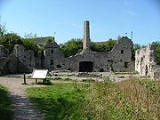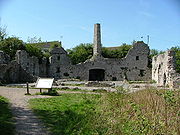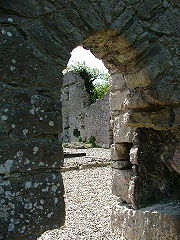
Llys Euryn
Encyclopedia
The ruined remains of Llys Euryn sit upon a wooded shoulder of Bryn Euryn
— a limestone hill on the outskirts of Rhos-on-Sea
in the county of Conwy
, north Wales
.
Three sides of the building remain, with the remains of interior walls, a complete fireplace and chimney stack rising to around 50 feet, two other fireplaces and windows. More than anything else, its history makes this one of the more intriguing and important historical buildings in north Wales.

(d.1246) — full name Ednyfed Fychan ap Cynwrig — who was seneschal
to the Kingdom of Gwynedd
in northern Wales, serving Llywelyn the Great
and his son Dafydd ap Llywelyn
. He was the ancestor of Owen Tudor
and thereby of the Tudor dynasty
.
It is thought that the house was burnt in 1409 during the revolt of Owain Glyndŵr
and restored or rebuilt shortly afterwards. The present structure is late medieval and may be the house occupied by the Conwy Family until 1629 when it was sold to Sir Peter Mutton.
During the working life (end of the 19th century) of the nearby limestone quarry, a small hut was built against one of the walls which was believed to house the blasting materials.
An amateur attempt was made to demolish the distinctive chimney stack and although a hole was blown in the side of the fireplace, the chimney remained standing. The site was left over-grown and largely over-looked until the late 1990s.
 During 1998/1999 the site was subject to a serious conservation project. Much of the vegetation was stripped away, the interior walls and a large fireplace were uncovered, the blasting hut removed and the hole in the chimney filled-in. Finally, stone chippings added to prevent further vegetation growth and an informative sign about the sites history was erected.
During 1998/1999 the site was subject to a serious conservation project. Much of the vegetation was stripped away, the interior walls and a large fireplace were uncovered, the blasting hut removed and the hole in the chimney filled-in. Finally, stone chippings added to prevent further vegetation growth and an informative sign about the sites history was erected.
Bryn Euryn
Bryn Euryn is a mountain which is a Site of Special Scientific Interest in the preserved county of Clwyd, north Wales; .- External link:*...
— a limestone hill on the outskirts of Rhos-on-Sea
Rhos-on-Sea
Rhos-on-Sea also known as Llandrillo-yn-Rhos in Welsh, or Rhos or Llandrillo , is a seaside resort in Conwy County Borough, Wales. The population was 7,110 in 2001. It is a mile to the north but effectively a suburb of Colwyn Bay, on the coast of North Wales...
in the county of Conwy
Conwy
Conwy is a walled market town and community in Conwy County Borough on the north coast of Wales. The town, which faces Deganwy across the River Conwy, formerly lay in Gwynedd and prior to that in Caernarfonshire. Conwy has a population of 14,208...
, north Wales
Wales
Wales is a country that is part of the United Kingdom and the island of Great Britain, bordered by England to its east and the Atlantic Ocean and Irish Sea to its west. It has a population of three million, and a total area of 20,779 km²...
.
Three sides of the building remain, with the remains of interior walls, a complete fireplace and chimney stack rising to around 50 feet, two other fireplaces and windows. More than anything else, its history makes this one of the more intriguing and important historical buildings in north Wales.

History
Llys Euryn was one of the local estates in the Dinerth area owned and occupied by Ednyfed FychanEdnyfed Fychan
Ednyfed Fychan , full name Ednyfed Fychan ap Cynwrig, was a Welsh warrior who became seneschal to the Kingdom of Gwynedd in Northern Wales, serving Llywelyn the Great and his son Dafydd ap Llywelyn...
(d.1246) — full name Ednyfed Fychan ap Cynwrig — who was seneschal
Seneschal
A seneschal was an officer in the houses of important nobles in the Middle Ages. In the French administrative system of the Middle Ages, the sénéchal was also a royal officer in charge of justice and control of the administration in southern provinces, equivalent to the northern French bailli...
to the Kingdom of Gwynedd
Kingdom of Gwynedd
Gwynedd was one petty kingdom of several Welsh successor states which emerged in 5th-century post-Roman Britain in the Early Middle Ages, and later evolved into a principality during the High Middle Ages. It was based on the former Brythonic tribal lands of the Ordovices, Gangani, and the...
in northern Wales, serving Llywelyn the Great
Llywelyn the Great
Llywelyn the Great , full name Llywelyn ab Iorwerth, was a Prince of Gwynedd in north Wales and eventually de facto ruler over most of Wales...
and his son Dafydd ap Llywelyn
Dafydd ap Llywelyn
Dafydd ap Llywelyn was Prince of Gwynedd from 1240 to 1246. He was for a time recognised as Prince of Wales.- Descent :...
. He was the ancestor of Owen Tudor
Owen Tudor
Sir Owen Meredith Tudor was a Welsh soldier and courtier, descended from a daughter of the Welsh prince Rhys ap Gruffudd, "Lord Rhys". However, Owen Tudor is particularly remembered for his role in founding England's Tudor dynasty – including his relationship with, and probable secret marriage to,...
and thereby of the Tudor dynasty
Tudor dynasty
The Tudor dynasty or House of Tudor was a European royal house of Welsh origin that ruled the Kingdom of England and its realms, including the Lordship of Ireland, later the Kingdom of Ireland, from 1485 until 1603. Its first monarch was Henry Tudor, a descendant through his mother of a legitimised...
.
It is thought that the house was burnt in 1409 during the revolt of Owain Glyndŵr
Owain Glyndwr
Owain Glyndŵr , or Owain Glyn Dŵr, anglicised by William Shakespeare as Owen Glendower , was a Welsh ruler and the last native Welshman to hold the title Prince of Wales...
and restored or rebuilt shortly afterwards. The present structure is late medieval and may be the house occupied by the Conwy Family until 1629 when it was sold to Sir Peter Mutton.
During the working life (end of the 19th century) of the nearby limestone quarry, a small hut was built against one of the walls which was believed to house the blasting materials.
An amateur attempt was made to demolish the distinctive chimney stack and although a hole was blown in the side of the fireplace, the chimney remained standing. The site was left over-grown and largely over-looked until the late 1990s.


